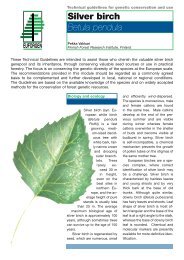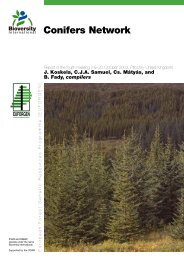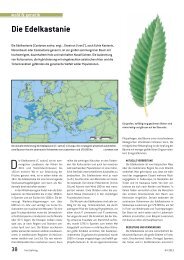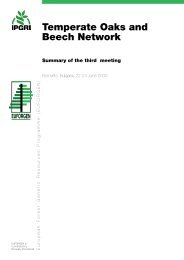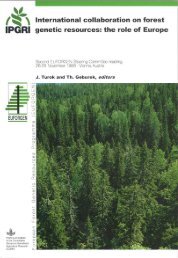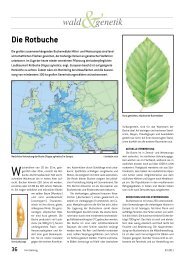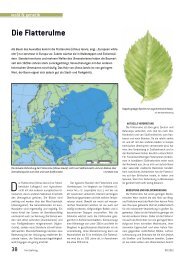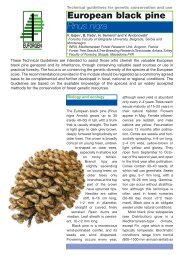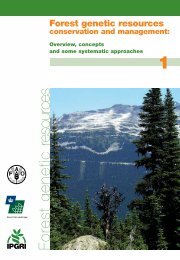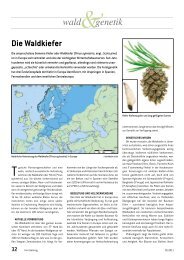Pinus halepensis - Euforgen
Pinus halepensis - Euforgen
Pinus halepensis - Euforgen
You also want an ePaper? Increase the reach of your titles
YUMPU automatically turns print PDFs into web optimized ePapers that Google loves.
EUFORGEN<br />
Technical guidelines for genetic conservation and use<br />
Aleppo and Brutia pines<br />
<strong>Pinus</strong> <strong>halepensis</strong>/<strong>Pinus</strong> brutia<br />
Bruno Fady1 , Hacer Semerci2 and Giovanni G. Vendramin3 1 INRA, Mediterranean Forest Research Unit, Avignon, France<br />
2 Forest Tree Seeds and Tree Breeding Research Directorate, Gazi-<br />
Ankara, Turkey<br />
3 CNR, Institute of Plant Genetics, Firenze, Italy<br />
These Technical Guidelines are intended to assist those who cherish the valuable Aleppo pine<br />
and Brutia pine genepools and wish to ensure their sustainability, through conserving important<br />
seed sources or use in practical forestry. The focus is on conserving the genetic diversity of the<br />
species at the European scale. The recommendations provided in this module should be<br />
regarded as a commonly agreed basis to be complemented and further developed in local,<br />
national or regional conditions. The Guidelines are based on the available knowledge of the<br />
species and on widely accepted methods for the conservation of forest genetic resources.<br />
Biology and ecology<br />
Aleppo pine (<strong>Pinus</strong> <strong>halepensis</strong><br />
Mill.) has a pedunculate cone,<br />
and fine, flexible, light green needles<br />
5–10 cm long. Brutia pine<br />
(<strong>Pinus</strong> brutia Ten.) has a sessile<br />
cone and strong, dark green<br />
needles 10–18 cm long. Both<br />
species are wind-pollinated and<br />
allogamous. Male and female<br />
flowers are located on different<br />
parts of a tree (monoecy). Both<br />
species are extremely prolific<br />
seed dispersers and can colonize<br />
open and disturbed<br />
areas easily.<br />
Aleppo and<br />
Brutia pine<br />
forests can grow<br />
on all substrates and<br />
almost all bioclimates<br />
of the Mediterranean<br />
region. They can be found<br />
at altitudes of 0–600 m in the<br />
northern Mediterranean and<br />
0–1400 m in the southern<br />
Mediterranean (thermo- and<br />
meso-Mediterranean levels).<br />
Locally, they can reach higher<br />
altitudes, e.g. 2600 m for
inus <strong>halepensis</strong> P<br />
ppo and Brutia pines<strong>Pinus</strong> <strong>halepensis</strong> <strong>Pinus</strong> brutiaAleppo and Brutia pines<strong>Pinus</strong> <strong>halepensis</strong><br />
P. <strong>halepensis</strong> in the Higher Atlas<br />
of Morocco and 1650 m for<br />
P. brutia in the Taurus Mountains<br />
of Turkey. At the upper limit of<br />
their distribution, they often constitute<br />
a pre-forest colonizing<br />
stage or are part of a mixed pineoak<br />
forest.<br />
Optimal development of<br />
P. <strong>halepensis</strong> forests occurs at<br />
annual rainfalls of 350–700 mm<br />
and absolute mean minimum<br />
temperatures between –2 and<br />
+10°C (semi-arid and sub-humid<br />
bioclimates). Optimal development<br />
of P. brutia forests requires<br />
higher rainfalls but accepts a<br />
wider range of temperatures<br />
(absolute mean minimum temperatures<br />
between –5 and +10°C,<br />
sub-humid and humid bioclimates).<br />
Distribution Importance and use<br />
<strong>Pinus</strong> <strong>halepensis</strong> and P. brutia<br />
form a group of related species<br />
that can intercross, but occupy<br />
different geographical ranges<br />
and bioclimates.<br />
Aleppo pine forests cover<br />
extensive areas in the western<br />
Mediterranean: Spain, France,<br />
Italy, Croatia, Albania, Greece,<br />
Morocco, Algeria, Tunisia, Libya<br />
and Malta. A few natural and artificial<br />
populations can be found in<br />
the eastern Mediterranean in<br />
Turkey, Syria, Israel, Jordan and<br />
Lebanon. Total forest cover is<br />
estimated to be approximately<br />
3.5 million hectares.<br />
Brutia pine forests cover<br />
extensive areas in the Eastern<br />
Mediterranean: Greece, Turkey,<br />
Cyprus, Syria and Lebanon. A<br />
few small populations can be<br />
found in Iraq and Iran.<br />
Other related taxonomic<br />
groups are<br />
present in Ukraine<br />
(Crimea, P. stankewiczii<br />
Sukaczew), around the<br />
Black Sea (Georgia, Russian<br />
Federation, Ukraine, P. pithyusa<br />
Stevenson) and in the Caucasus<br />
(Azerbaijan, Georgia, Iran,<br />
Turkey, P. eldarica Medw.). Total<br />
forest cover is estimated to be<br />
over 4 million hectares, of which<br />
3.8 million hectares are in Turkey.<br />
Aleppo and Brutia pines represent<br />
the only or main source of<br />
wood and forest cover in many<br />
Mediterranean countries. Economically,<br />
P. brutia is the most<br />
important conifer species in<br />
Turkey; P. <strong>halepensis</strong> is the most<br />
important forest species of North<br />
Africa, and has high ecological<br />
importance in southern France<br />
and Italy, especially at the urbanforest<br />
interface. Mean productivity<br />
is approximately 1–2 m 3<br />
ha -1 year -1 for Aleppo pine, and<br />
2–3 m 3 ha -1 year -1 for Brutia pine.<br />
Maximum yield can reach<br />
12–15 m 3 for both species. The<br />
wood of these Mediterranean<br />
pines is used for many purposes:<br />
construction, industry, carpentry,<br />
firewood and pulp. Seeds are<br />
also used for making pastry.
inus brutia <strong>Pinus</strong><br />
<strong>Pinus</strong> brutiaAleppo and Brutia pines<strong>Pinus</strong> <strong>halepensis</strong> <strong>Pinus</strong> brutiaAleppo and Brutia pinesP<br />
Genetic knowledge<br />
Genetic inventories using biochemical<br />
and DNA markers have<br />
demonstrated that genetic diversity<br />
is geographically structured.<br />
Most P. <strong>halepensis</strong> diversity was<br />
found in Greek and Spanish populations<br />
although other populations<br />
had lower diversity than<br />
other conifer species. This is<br />
consistent with the hypothesis of<br />
a recent expansion of the<br />
species (in the last 10 000 years)<br />
from these two refugial areas,<br />
with colonizing populations<br />
establishing by migration of a<br />
limited number of individuals<br />
(founder effect) and/or population<br />
dynamics regulated by fire<br />
(population bottlenecks). Genetic<br />
diversity is higher for P. brutia<br />
and roughly separates<br />
Western and Eastern populations.<br />
Controlled pollination<br />
experiments and monitoring<br />
of sympatric east Mediterranean<br />
populations using<br />
molecular markers have<br />
demonstrated that unidirectional<br />
gene flow is possible from<br />
P. <strong>halepensis</strong> to P. brutia resulting<br />
in the emergence of hybrids.<br />
Hybridization is not possible<br />
using P. brutia as pollen parent.<br />
Provenance and laboratory<br />
tests have revealed significant<br />
geographic patterns in adaptive<br />
trait variability. Although both<br />
species demonstrate polycyclic<br />
annual growth patterns, initial<br />
shoot units are smaller in<br />
P. <strong>halepensis</strong>. The easternmost<br />
P. <strong>halepensis</strong> provenances tend<br />
to have higher juvenile growth.<br />
<strong>Pinus</strong> <strong>halepensis</strong> is better adapted<br />
to drought but less adapted<br />
to cold than P. brutia. However,<br />
under severe water-stress conditions,<br />
P. <strong>halepensis</strong> has an<br />
increased sensitivity to the fungus<br />
Sphaeropsis sapinea. Both<br />
species are sensitive to the pine<br />
procecionnary moth Thaumetopoea<br />
pityocampa which can<br />
cause severe defoliation. <strong>Pinus</strong><br />
<strong>halepensis</strong> is sensitive to the pine<br />
bast scale Matsucoccus josephii,<br />
although P. brutia is resistant to<br />
it.<br />
These, along with ecological<br />
studies, have been used to<br />
define seed-collection zones and<br />
seed stands in several countries<br />
(e.g. 29 P. <strong>halepensis</strong><br />
seed stands<br />
in France).<br />
Threats to<br />
genetic diversity<br />
Aleppo and Brutia pines are not<br />
considered ecologically threatened<br />
as a whole. However P.<br />
pityusa is considered vulnerable<br />
because of population size<br />
reduction linked to habitat<br />
decline (IUCN red list). <strong>Pinus</strong><br />
eldarica has a patchy distribution<br />
and its genetic diversity is lowest<br />
among the taxa of this group.<br />
Insects such as Matsucoccus<br />
josephii represent a major threat<br />
in the Eastern Mediterranean.<br />
Thaumatopea pityocampa can<br />
also induce severe defoliation<br />
throughout the distribution area<br />
of both pines although it does<br />
not often lead to mortality.<br />
Recently, the canker Crumenulopsis<br />
sororia has started to<br />
cause severe defoliation<br />
and dieback on<br />
P. <strong>halepensis</strong> in<br />
France. The impact of<br />
forest fires is ambivalent.<br />
Although they actually promote<br />
regeneration, they could be<br />
responsible for rare allele<br />
changes over generations,<br />
explain the very low diversity<br />
found in P. <strong>halepensis</strong> and promote<br />
the spreading of<br />
P. <strong>halepensis</strong> genes into P. brutia<br />
forests. Among-region seed<br />
transfers have led to significant<br />
frost or water-stress damage<br />
after planting when ill-adapted<br />
material was used. Reducing<br />
local population adaptability<br />
through gene flow from plantations<br />
is also a risk. Finally,
<strong>halepensis</strong> Pin<br />
<strong>Pinus</strong> <strong>halepensis</strong> <strong>Pinus</strong> brutiaAleppo and Brutia pines<strong>Pinus</strong> <strong>halepensis</strong> <strong>Pinus</strong> brutiaAleppo and<br />
because these species (and<br />
especially P. <strong>halepensis</strong>) are<br />
highly resistant to drought, they<br />
are often the last forest species<br />
to be found at desert or steppe<br />
margins. Global warming and its<br />
collateral modification of rainfall<br />
regimes may dramatically modify<br />
their distribution ranges.<br />
Guidelines for genetic<br />
conservation and use<br />
Current conservation measures<br />
undertaken at national levels<br />
most commonly include in situ<br />
gene conservation networks<br />
specifically designed for the target<br />
species (e.g. in Turkey, 52<br />
P. brutia conservation units) and<br />
forest reserves or national parks<br />
which include the target species.<br />
Ex situ measures include clonal<br />
archives, cold storage seed<br />
banks and DNA banks.<br />
To increase the efficiency<br />
of in situ genetic resource<br />
conservation, a concerted<br />
management effort should<br />
be carried out range-wide.<br />
Although transfer of seed<br />
material is often legally possible,<br />
it should be avoided<br />
across zones and countries<br />
with different ecological<br />
requirements, notably<br />
because of cold, drought and<br />
insect damage risks.<br />
Locally, some populations<br />
require specific attention and<br />
appropriate forestry practice.<br />
Marginal populations. As populations<br />
at high altitudes, in desert<br />
margins and mixed forests may<br />
contain valuable genes (resistance<br />
to drought, cold, pests) for<br />
adaptation under global warming,<br />
efforts such as gene<br />
reserves should be made<br />
to conserve them.<br />
Population under recurrent<br />
forest fires. Because they are<br />
adapted to forest fires, both<br />
pines usually regenerate well<br />
after fire, using the seed bank<br />
released from serotinous cones.<br />
If regeneration happens to be<br />
poor in the first 2 years after fire,<br />
and if only a few isolated seed<br />
trees remain in the burnt area,<br />
artificial regeneration should be<br />
used to counteract the risk of<br />
genetic erosion in the juveniles.<br />
In this case, seed lots collected<br />
from large genepools should be<br />
used (e.g. at least 30 trees per<br />
population from at least three<br />
populations from a single seed<br />
zone).<br />
Populations where hybridization<br />
may occur. Planting Aleppo<br />
pine where Brutia pine is present<br />
should be avoided in areas<br />
where frost and potential pest<br />
damage are limiting factors, or<br />
strictly monitored in areas where<br />
drought is the limiting factor.<br />
Owing to the anisotropy of<br />
between-species gene flow, the<br />
impact should be reduced when<br />
planting Brutia pine in the vicinity<br />
of Aleppo pine forests.
<strong>Pinus</strong> <strong>halepensis</strong><br />
Aleppo and Brutia pines<strong>Pinus</strong> <strong>halepensis</strong> <strong>Pinus</strong> brutiaAleppo and Brutia pines<strong>Pinus</strong> h<br />
Distribution range of Aleppo pine<br />
Distribution range of Brutia pine
<strong>Pinus</strong> brutia Pi<br />
alepensis <strong>Pinus</strong> brutiaAleppo and Brutia pines<strong>Pinus</strong> <strong>halepensis</strong> <strong>Pinus</strong> brutiaAleppo and Bruti<br />
EUFORGEN<br />
These Technical Guidelines were<br />
produced by members of the<br />
EUFORGEN Conifers Network.<br />
The objective of the Network is to<br />
identify minimum genetic conservation<br />
requirements in the long<br />
term in Europe, in order to reduce<br />
the overall conservation cost and<br />
to improve the quality of standards<br />
in each country.<br />
Citation: Fady, B., H. Semerci and<br />
G.G. Vendramin. 2003. EUFOR-<br />
GEN Technical Guidelines for<br />
genetic conservation and use for<br />
Aleppo pine (<strong>Pinus</strong> <strong>halepensis</strong>)<br />
and Brutia pine (<strong>Pinus</strong> brutia).<br />
International Plant Genetic<br />
Resources Institute, Rome, Italy.<br />
6 pages.<br />
Drawings: <strong>Pinus</strong> <strong>halepensis</strong>, Claudio<br />
Giordano. © IPGRI, 2003.<br />
ISBN 92-9043-571-2<br />
EUFORGEN Secretariat c/o IPGRI<br />
Via dei Tre Denari, 472/a<br />
00057 Maccarese (Fiumicino)<br />
Rome, Italy<br />
Tel. (+39)066118251<br />
Fax: (+39)0661979661<br />
euf_secretariat@cgiar.org<br />
Selected bibliography<br />
Bariteau, M., R. Huc and G.G. Vendramin (coordinators). 2001 Adaptation and<br />
selection of Mediterranean <strong>Pinus</strong> and Cedrus for sustainable afforestation<br />
of marginal lands. Final report of EU Project FAIR CT95-0097, 173 p.<br />
Bucci, G., M. Anzidei, A. Madaghiele and G.G. Vendramin. 1998. Detection of<br />
haplotypic variation and natural hybridization in <strong>halepensis</strong>-complex pine<br />
species using chloroplast simple sequence repeat (SSR) markers. Molecular<br />
Ecology 7(12):1633-1643.<br />
Conkle, M.T., G. Schiller and C. Grunwald. 1988. Electrophoretic analysis of<br />
diversity and phylogeny of <strong>Pinus</strong> brutia and closely related taxa. Systematic<br />
Botany 13(3):411-424.<br />
Kaundun, S.S., B. Fady and Ph. Lebreton. 1997. Genetic differences between<br />
<strong>Pinus</strong> <strong>halepensis</strong>, <strong>Pinus</strong> brutia and <strong>Pinus</strong> eldarica based on needle<br />
flavonoids. Biochemical Systematics and Ecology 25(6):553-562.<br />
Ne’eman, G. and L. Trabaud (eds.). 2000. Ecology, biogeography and management<br />
of <strong>Pinus</strong> <strong>halepensis</strong> and P. brutia forest ecosystems in the Mediterranean<br />
basin. Backhuys Publishers, Leiden, The Netherlands. 407 pages.<br />
The distribution map was compiled by members of the EUFORGEN<br />
Conifers Network based on an earlier map published by W.B.Critchfield &<br />
E.L.Little, Jr. in 1966 (Geographic Distibution, of the Pines of the World,<br />
USDA Forest Service Misc. Publication, 991 pages).<br />
More information<br />
www.euforgen.org



